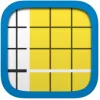Take a look inside 10 images
Number Pieces, by The Math Learning Center
Pros: Base-ten blocks are a fantastic learning tool, and this version takes up far less space in your cupboard than the wooden sets.
Cons: Controls don't always work well, equation entry has a character limit, and the visual style isn't terribly engaging.
Bottom Line: Every teacher should have a set of base-ten blocks, and this is a workable but limited substitute when compared to the real deal.
It's possible to use Number Pieces in any situation where you'd use traditional physical base-ten blocks, so long as you don't need the beastly 1,000 cube (which is awesome but not included here). It's great for young learners just getting the basics of the decimal system and useful for all arithmetic operations. You can also pull it out again in algebra and geometry to make connections between abstract processes and concrete relationships already mastered.
It's probably not a great idea to replace your physical blocks with Number Pieces or to hold off on buying a set just because this is free. It's critical that kids associate a particular weight, feeling, and emotional attachment to numbers, and that doesn't happen with a fingertip on a piece of glass the same way it does with a tiny cube that handily weighs exactly one gram. Number Pieces is a tough sell as a permanent substitute.
Number Pieces is a virtual set of base-ten blocks with some extra handy tools for annotation and measurement. Users can tap units, tens, or hundreds blocks to add them to the whiteboard, change their color from yellow to red to green, rotate them, and join them or break them apart. Groups of blocks can be selected all at once by dragging a finger around them, allowing easy editing or deleting of the whole cluster. Blocks helpfully snap together at the edges, or they can be arranged free-form.
A hand-drawing pen tool and equation editor give the app some extra oomph over its physical rivals. Users can draw all over the blocks to make notes, circle groups, or write numbers; the equation editor adds crisp, easy-to-read math figures to the field, formalizing systems and relationships. It's a totally open-ended tool, made for use with existing curriculum. Note: Number Pieces Basic is also available, with fewer features and aimed at primary school students.
Physical manipulation of objects to discover numerical properties is critical for developing early math skills, so base-ten blocks have long been included in the early childhood toolkit. To that end, Number Pieces is fantastic for learning. There's still no consensus as to whether virtual versions are quite as effective as physical tools, but a kid who learns with this app is very likely to thrive more than a child who learns with no manipulatives at all. Sticky controls could stand in the way of reaching learning goals here, so be aware of that potential pitfall.
There's no doubt that the convenience factor is a big plus for Number Pieces. Rather than dragging a bin of blocks, a roll of butcher paper, and a stack of markers around, this app lets teachers have everything they need on their tablet. This kind of at-your-fingertips availability opens up plenty of learning opportunities, and that's a big win.


















